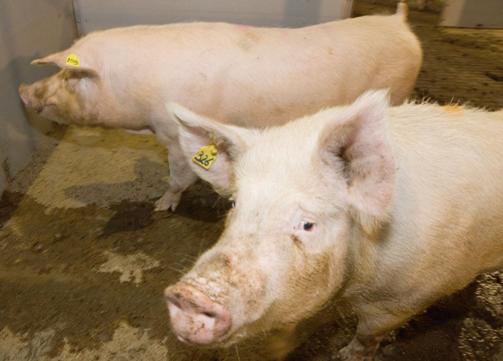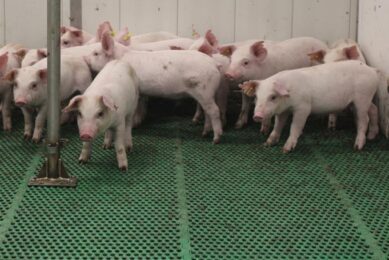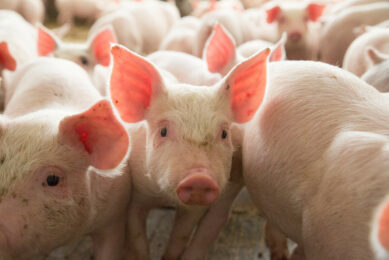A look at phase feeding of sows during gestation

Not a single day is the same in the life of a gestating sow. Each day marks a further growth of the unborn piglets – and in theory each day would require a new nutritional strategy. By dividing gestation into three phases, sow nutritional needs can be more clearly defined in detail: What do they need?
During gestation the objective should be to feed the sow to ensure that:
- she produces an adequate number of piglets of acceptable body weight
- the mammary glands are properly developed to safeguard optimum production of high quality colostrum and milk
- the target body weight gain and body condition and composition at parturition are achieved without compromising performance during lactation or subsequently.
These different objectives require knowledge of the changing nutritional needs of the sow during gestation and the appropriate feeding strategy. Generally the feed needs are based on the energy requirements of the animal and these are presented in Table 1 and Figure 1.
Basically, the feed requirements of the sow during gestation can be divided into three separate phases: Early (day 1-28), Middle (day 29-84) and Late (day 85-115), as discussed below.
Early gestation
The feeding of the gilt just after mating differs from that of the mature sow, in that excessive feed intake during this period reduces embryo survival and hence potential litter size. Indeed, embryo mortality in early gestation in gilts is associated with lower circulating levels of progesterone which is required for preparing the uterus for embryo implantation. Progesterone also influences the secretion of the uterine secretory proteins uteroferrin and retinol-binding protein, which enhance embryo survival. It is therefore recommended that gilts be fed 2.0-2.2 kg feed/day of a good quality gestation or gilt rearer ration for the first three to four weeks post mating.
On the other hand, in mature sows, and especially in those that have lost considerable body reserves and body condition during lactation and post-weaning, increasing the feed allowance during early gestation may be beneficial.This is necessary to attain and sustain the correct metabolic and endocrine status vital to successful embryo and foetal development and survival. In a recent study from 2011, Dr Lia Hoving and others showed that sows fed 3.25 kg/day of a gestation diet from day 3 to 32 of gestation had larger litter sizes (15.2 compared with 13.2) than sows fed the customary level of 2.5 kg/day. This extra feed helped the sows to promptly recover the body weight and condition that they had lost; it may also improve embryo and placental development through an increased availability of specific micro-nutrients, such as iron, selenium, vitamin A, folic acid etc. The amount of extra feed to be given will depend on the extent of the loss of body weight and condition; some suggestions are given in Table 2.
Mid gestation
In mid gestation there is a 2-3 MJ/day increase in energy requirements which can be met by an 0.15-0.20 kg/day increase in feed. Most of this increase is for maintenance and maternal body gain to ensure that the animal maintains a body condition score of 3.0-3.5 (scale 1-5). The requirements for mammary and foetal development are still relatively small at this stage. However, it is during this period that primary and secondary muscle fibres are developing, which influence piglet birth weight and hence performance to slaughter.
Primary muscle fibres develop between day 30 and 50 of gestation and are influenced by the genetic make-up of the animal. Secondary muscle fibres, of which there are about 30 for each primary muscle fibre, develop between day 50-80 of gestation. Thus, it is the secondary muscle fibre number that influences birth weight and performance through to slaughter. Secondary muscle fibre development is more dependent on maternal and environmental stimuli; low maternal feed levels reduce muscle fibre number, whereas higher maternal nutrition results in a higher number of muscle fibres in specific muscles.
Muscle fibre number has been positively associated with higher birth weight, better post-weaning performance and enhanced meat quality, though the results from several studies are equivocal. However, as litter size increases in modern hyper-prolific sows there may be a need to increase feed intake in this period to boost secondary muscle fibre development as this may increase birth weight, as well as reduce within litter variation.
Late gestation
In late pregnancy, when most of the foetal and mammary growth and development occurs, there is a significant increase in the nutritional needs of the sow. Foetal and mammary growth is markedly accelerated; in the last four to six weeks foetal weight increases five-fold and mammary protein content 27-fold, increasing nutritional needs dramatically. For example, overall energy requirements increase by about 10-15%, but the specific requirement for conceptus gain doubles. Each extra piglet produced requires an extra 50 g of feed/day. Feed allowances should therefore be increased, and it is common to provide an extra 0.3-0.5 kg during this period.
Alternatively, the sow could be fed to ensure a body condition score of 3.5 regardless of litter size; this not only safeguards the sow, but also ensures good piglet birth weight. It is important that the sow does not become catabolic during this period, as this will influence foetal growth, with piglets born of lower birth weight and a greater variation in birth weight within the litter. It is also important that sows are kept in ideal environmental conditions. If they are kept below their lower critical temperature then feed allowances must be increased by 4% for each 1˚C.
Amino acids
While energy is the most limiting factor in the nutrition of the gestating sow and the recommended feed levels are based on the energy requirement of the animal, the amino acid requirements also increase during gestation. In the past it has been assumed that the balance of amino acids remains constant throughout gestation. However, in early and mid-gestation the major requirement is for maintenance and maternal protein gain, whereas in late gestation the higher demands for foetal and mammary development may need a fine-tuning of the amino acid balance.
The extent to which it may need to change has recently been reported for threonine by Professor Ron Ball and colleagues at the University of Alberta, Canada (Table 3) who commented that threonine, rather than lysine may be the first limiting amino acid for sows in late gestation. The pattern of other amino acids is currently being evaluated. The consequences of the changing amino acid requirement may call for different diets during gestation, though the effects on piglet growth and development need to be further assessed.
Table 4 shows the changing lysine and threonine content of diets for sows of different parities and stages of gestation.
Mineral and vitamin requirements
It is not just a question of meeting the energy and amino acid needs, those for minerals and vitamins also increase during gestation, especially in the final two to three weeks, and the higher the productivity of the sow, the greater the need. In relation to minerals, Mahan and others have shown that over the period day 80 to day 115 of gestation, the mineral content of foetal tissue increases three- to sixfold, depending on the mineral, and this may be even higher in hyper-prolific sows.
As litter size increases, larger quantities would be expected to be transferred to the developing foetuses. If the diet of the sow, and/or her feed intake, does not provide adequate levels of minerals to meet demands, the sow will mobilise body reserves before the end of parity and this may compromise subsequent lactation and reproductive performance. One way to overcome these difficulties is to provide organic, rather than inorganic minerals, which have higher bio-availability and which better meet the animals’ needs.
Conclusions
The nutrient requirements of the sow change during gestation and the feed provision must meet this demand; hence the need for phase feeding. In terms of energy, a one diet-strategy may suffice (12.5 MJ ME/kg), with the levels increasing at day 85 of gestation. The amino acid requirements, too, increase, though there may also be a change in the balance of amino acids between early/mid and late gestation and this may necessitate a diet of differing amino acid composition (Table 4). Similarly for minerals (and possibly also vitamins); there is a dramatic increase in requirements over the last four weeks of gestation and it is important to provide the correct levels in the most available form to the animal. Furthermore, there is a change in the rate at which different minerals are retained which needs to be taken into account.
The practicality of feeding different diets should be possible in a computerised sow feeding station. Alternatively, a basic gestation diet may be fed with a ‘top-dressing’ supplement provided from day 84 of gestation. The question remains whether such a strategy will lead to improvements in sow reproductive performance and piglet quality and whether it is cost-effective. This needs to be tested in commercial production systems.











